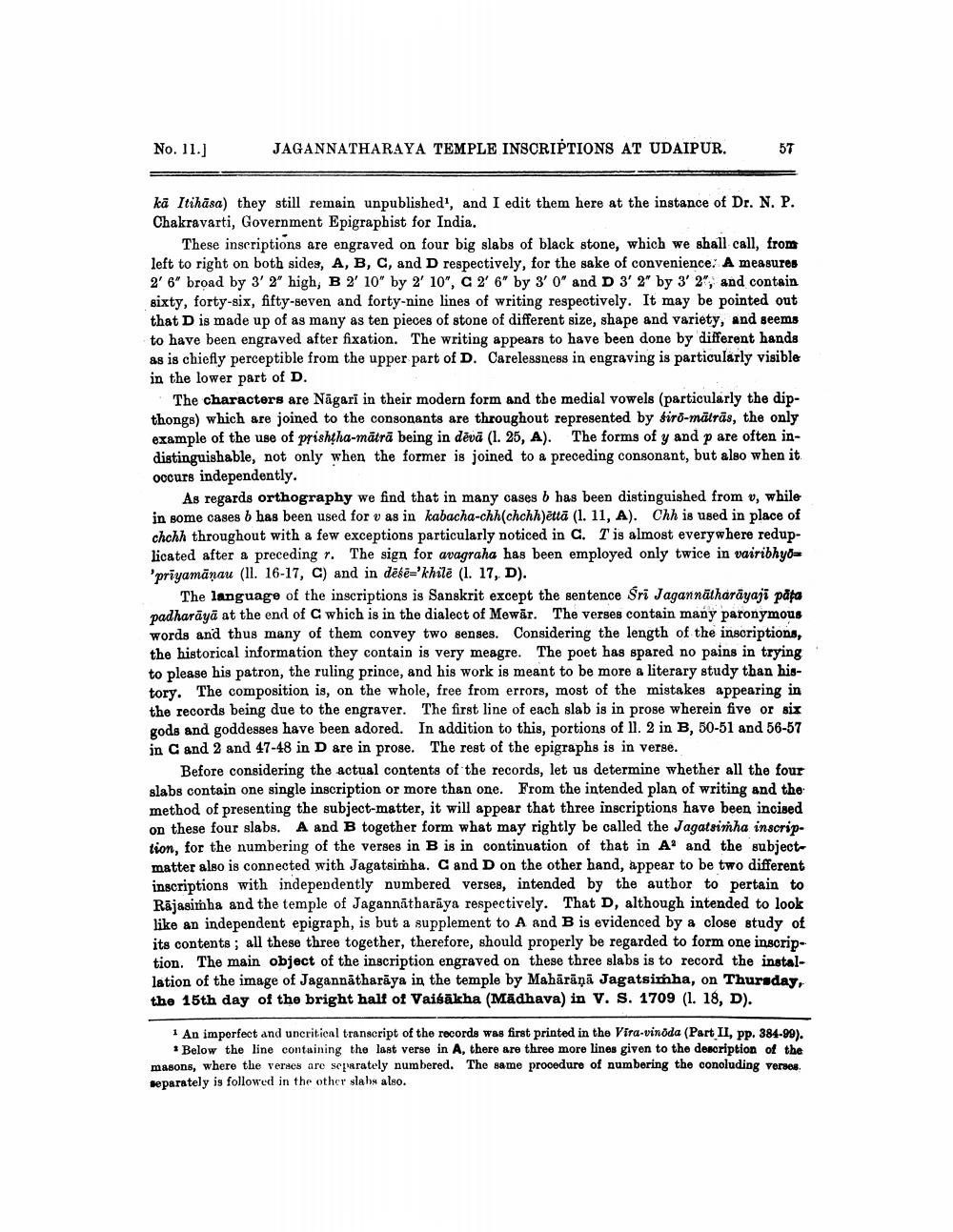________________
No. 11.)
JAGANNATHARAYA TEMPLE INSCRIPTIONS AT UDAIPUR.
57
kā Itihāsa) they still remain unpublished", and I edit them here at the instance of Dr. N. P. Chakravarti, Government Epigraphist for India.
These inscriptions are engraved on four big slabs of black stone, which we shall call, from left to right on both sides, A, B, C, and D respectively, for the sake of convenience. A measures 2' 6" broad by 3'2" high, B2' 10" by 2' 10", C 2' 6" by 3' 0" and D 3' 2" by 3' 2", and contain sixty, forty-six, fifty-seven and forty-nine lines of writing respectively. It may be pointed out that D is made up of as many as ten pieces of stone of different size, shape and variety, and seems to have been engraved after fixation. The writing appears to have been done by different hands as is chiefly perceptible from the upper part of D. Carelessness in engraving is particularly visible in the lower part of D.
The characters are Nāgari in their modern form and the medial vowels (particularly the dipthongs) which are joined to the consonants are throughout represented by siro-mātrās, the only example of the use of prishtha-mātrā being in dēvā (1. 25, A). The forms of y and p are often indistinguishable, not only when the former is joined to a preceding consonant, but also when it occurs independently.
As regards orthography we find that in many cases 6 has been distinguished from v, while in some cases b has been used for v as in kabacha-chh(chchh)ēttā (1. 11, A). Chh is used in place of chchh throughout with a few exceptions particularly noticed in C. T is almost everywhere reduplicated after a preceding r. The sign for avagraha has been employed only twice in vairibhyo priyamanau (11. 16-17, C) and in dēbē="khile (1. 17, D).
The language of the inscriptions is Sanskrit except the sentence Sri Jagannātharāyaji påta padharāyā at the end of C which is in the dialect of Mewar. The verses contain many paronymous words and thus many of them convey two senses. Considering the length of the inscriptions, the historical information they contain is very meagre. The poet has spared no pains in trying to please his patron, the ruling prince, and his work is meant to be more a literary study than history. The composition is, on the whole, free from errors, most of the mistakes appearing in the records being due to the engraver. The first line of each slab is in prose wherein five or six gods and goddesses have been adored. In addition to this, portions of 11. 2 in B, 50-51 and 56-57 in C and 2 and 47-48 in D are in prose. The rest of the epigraphs is in verse.
Before considering the actual contents of the records, let us determine whether all the four slabs contain one single inscription or more than one. From the intended plan of writing and the method of presenting the subject matter, it will appear that three inscriptions have been incised on these four slabs. A and B together form what may rightly be called the Jagatsinha inscription, for the numbering of the verses in B is in continuation of that in A' and the subjectmatter also is connected with Jagatsimha. C and D on the other hand, appear to be two different inscriptions with independently numbered verses, intended by the author to pertain to Rājasimha and the temple of Jagannatharāya respectively. That D, although intended to look like an independent epigraph, is but a supplement to A and B is evidenced by a close study of its contents; all these three together, therefore, should properly be regarded to form one inscription. The main object of the inscription engraved on these three slabs is to record the installation of the image of Jagannatharāya in the temple by Mahārāņā Jagatsinha, on Thursday, the 15th day of the bright half of Vaišākha (Madhava) in V. S. 1709 (1. 18, D).
1 An imperfect and uncritical transcript of the records was first printed in the Vira-vinoda (Part II, pp. 384-99).
1 Below the line containing the last verse in A, there are three more lines given to the description of the masons, where the verses are separately numbered. The same procedure of numbering the conoluding verses. separately is followed in the other slabs also.




